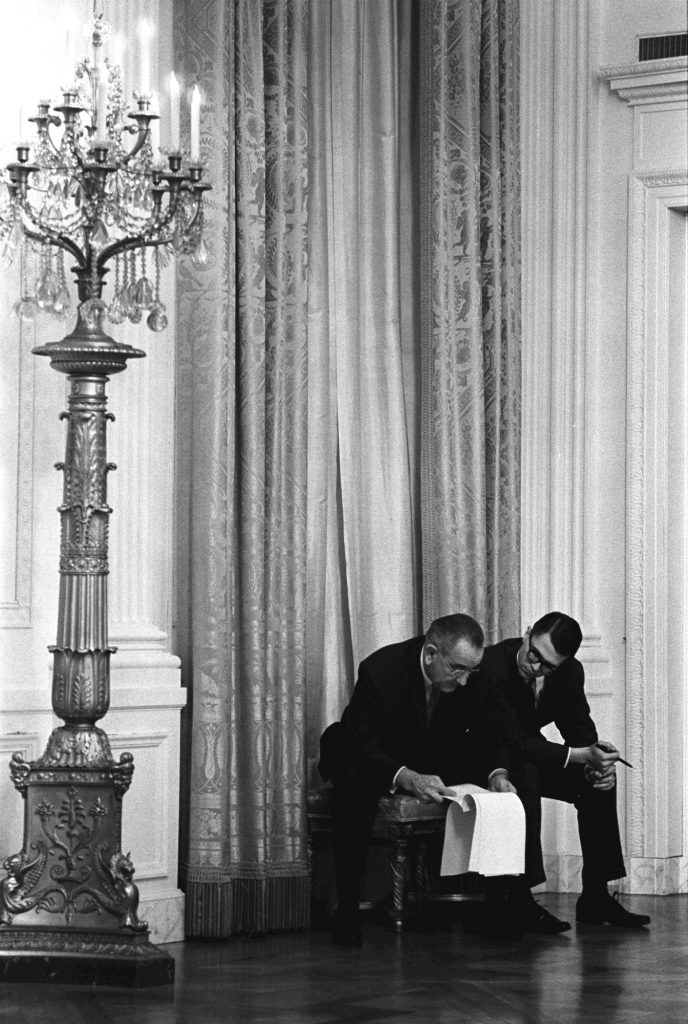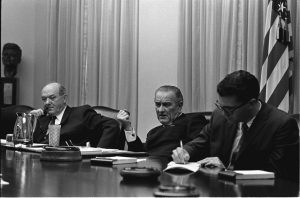
Macon, Georgia, native Tom Johnson (no relation to LBJ) shares some of his life experiences with me. He does so in memory of my father, who was also born in Macon. They met when Tom first came to the nation’s capital. As the president’s trusted bodyguard, my father made the young reporter feel welcomed in the White House.
______________
One hot summer day in August 1965, twenty-three-year-old Wyatt Thomas “Tommy” Johnson of Macon, Georgia, began his fellowship in the White House Press Office. The enthusiastic young man, who resembled Clark Kent with his dark-rimmed glasses and neatly parted hair, had a passion for journalism. He had worked for the Macon Telegraph since he was in high school and also while pursuing his journalism degree at the University of Georgia (UGA) and his MBA at the Harvard Business School. He had been mentored by one of the South’s best publishers – Peyton Anderson, who had funded his undergraduate and graduate education. And always, he was driven by his mother’s words of wisdom, “If you work hard, Tommy, and do right, you can accomplish anything you hope to accomplish in life.”
From Anderson, Tom learned not only the many facets of publishing a newspaper but also the moral responsibilities associated with delivering the news. When “Tommy” covered the 1961 story of the enrollment of the first black students, Charlayne Hunter and Hamilton Holmes, at UGA, he presented an objective account of the event for the school newspaper, The Red & Black. His close observance of the racial discrimination experienced by these students left an indelible impression on the young reporter. He befriended Hunter, an aspiring journalist, who (later Hunter-Gault) would embark on her own, very successful career in journalism.
Tom’s strong work ethic with extensive experience as a newspaperman made his application stand out in the competitive White House fellowship program. He was chosen as one of fifteen White House Fellows out of approximately three thousand applicants. President Johnson recognized Tom’s talent and asked him to remain as a member of his staff upon the program’s completion. However, Tom respectfully declined, explaining that he had an obligation to Peyton Anderson to return to Macon. Tom’s loyalty to his mentor further convinced the president that he wanted Tom on his White House staff. LBJ wrote to Anderson requesting permission for Tom to stay. Anderson proudly approved. Tom was promoted to Assistant White House Press Secretary, then to Deputy Press Secretary to the President the following year. He became an advisor to the president and attended top-secret national security council meetings.

Tom recalls the turmoil of 1968 and the president’s anguish over the death toll in Vietnam. On April 4, 1968, shortly after LBJ had announced that he would not seek another presidential term, Tom was monitoring the White House wire machines when, like a banshee’s warning, “all of the bells went into a prolonged scream.” Dr. Martin Luther King, Jr., had been shot. Tom ripped off the ticker tape and ran to the Oval Office where the president was meeting with former Georgia Governor Carl Sanders and Coca-Cola Chairman Robert Woodruff. In this historic setting, a Macon native delivered the tragic news of the shooting of Atlanta’s revered civil rights leader in the presence of two prominent Atlantans. LBJ initially slumped at the blow of this news and then jumped to the phone and began taking action.
When LBJ left office, Tom intended to return to the Macon Telegraph, but, once again, the president implored him to work for him in Texas. After corresponding with Anderson, Tom and his wife, Edwina, and two children accompanied the Johnsons to Texas. Tom’s responsibilities increased as he helped LBJ during the creation of the LBJ presidential library and the LBJ School of Public Affairs; coordinated speaking engagements; assisted with writing LBJ’s memoirs, and managed many of the LBJ family businesses.
After LBJ’s death in 1973, Tom returned to journalism. He served as the Executive Editor then Publisher of the Dallas Times Herald, and later became the CEO of the Los Angeles Times. During his tenure, these papers reached new heights of recognition and prosperity. In 1990, shortly before Operation Desert Storm, Tom became the president of CNN. Coverage of the war launched the network into worldwide recognition, and Tom soon became its CEO. Under his leadership, CNN earned multiple awards.
Tom has been the recipient of numerous honors over the years with inclusion among the Ten Outstanding Young Americans, Five Outstanding Young Texans, and Five Outstanding Young Georgians chosen by the United States, Texas, and Georgia Junior Chambers respectively. He was also awarded the Horatio Alger Award, the Walter Cronkite award for excellence in journalism, the Paul White Award, and the John Gardner Legacy of Leadership Award by the White House Fellows for lifetime achievement in public service.
Throughout his career, Tom never forgot Anderson’s support of “the boy from the other side of the tracks.” In 1973, he established the UGA School of Journalism’s Peyton T. Anderson Scholarship program. He maintains this program to this day. In addition, he has mentored numerous aspiring young journalists and goes out of his way to champion a friend in need, readily offering to throw out the lifeline when needed.
He has also not forgotten the president whose legacy he still honors. He is a frequent guest speaker for and Chairman-emeritus of the LBJ Presidential Foundation.
Yet, even with this extraordinary and prestigious life history, Tom made it a point to inform me that he still owns property in Macon. In his words, “Macon will always be my home.”
______________
Sources/Links:
Tom Johnson, in discussion with author, Rebecca Y. Vaughn, Aug 25, 2018, & Sept 10, 2018.
Weldon White, Jaclyn. Bestest: The Life of Peyton Took Anderson, Jr., Macon, Georgia: Mercer University Press, 2005.
Simon, Mollie. “Former CNN president Tom Johnson honors mentor with journalism forum.” Dec. 2, 1015. The Red&Black website. Accessed Sept. 9, 2018.
Simon, Mollie. “UGA alumni reflect on 55 years since desegregation.” Feb. 18, 2016. The Red&Black website. Accessed Sept. 9, 2018.
Nigut, Bill. “Former CNN President Tom Johnson on a lifetime in journalism.” Jan. 14, 2017. GPB news website. Accessed Sept. 8, 2018.
Dabkovich, John. “Intern who became one of LBJ’s closest aides remembers president.”Apr 26, 2016. kxan news website. Accessed Sept. 9, 2018.
TheLBJLibrary, “An evening with Tom Johnson, Kyle Longley, Bill Moyers, and Lynda Johnson Robb.” Jun 15, 2018. youtube.com. Accessed Sept. 8, 2018.
Tom Johnson. Presidential Leadership Scholars. https://www.presidentialleadershipscholars.org/staff/tom-johnson/ Accessed Sept. 11, 2018
Tom is indeed a fine man and journalist. It is important, I think, to remember the bright men and women that assist a president in fulfilling promises made to the American electorate. Tom was a great asset to LBJ is getting the message of the ‘Great Society’ to the people.
Rebecca, thanks for posting this exceptional article about Tom Johnson. I really enjoyed it.
I worked for Tom when he was publisher of the Los Angeles Times. He was an excellent publisher, respected by the entire staff.
Thank you for your comment!